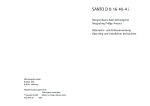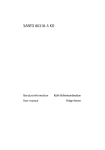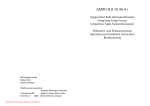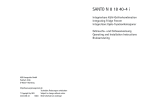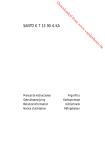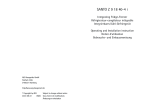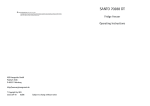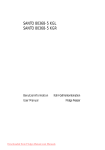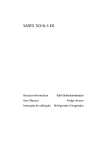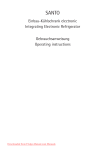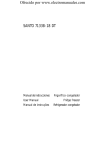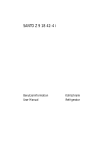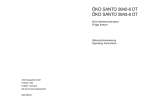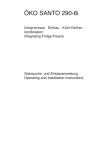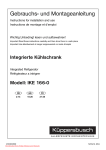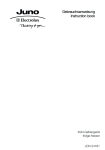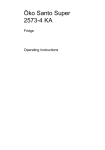Download Electrolux SANTO Z 9 18 42-4 I Operating instructions
Transcript
SANTO C 8 18 42-4 i Integrierbare Kühl-Gefrierkombination Integrating Fridge Freezer Gebrauchs- und Einbauanweisung Operating and Installation Instructions AEG Hausgeräte GmbH Postfach 1036 D-90327 Nürnberg http://www.aeg.hausgeraete.de Technische Änderungen vorbehalten © Copyright by AEG Subject to change without notice 2222 196-59 09/03 Sehr geehrte Kundin, sehr geehrter Kunde, bevor Sie Ihr neues Kältegerät in Betrieb nehmen, lesen Sie bitte diese Gebrauchsanweisung aufmerksam durch. Sie enthält wichtige Informationen zum sicheren Gebrauch, zum Aufstellen und zur Pflege des Gerätes. Bewahren Sie bitte die Gebrauchsanweisung zum späteren Nachschlagen auf. Geben Sie sie an eventuelle Nachbesitzer des Gerätes weiter. Hinweis: Diese Gebrauchsanweisung ist für mehrere technisch vergleichbare Modelle mit unterschiedlicher Ausstattung bestimmt. Beachten Sie bitte nur die Hinweise, die Ihre Geräteausführung betreffen. Mit dem Warndreieck und/oder durch Signalwörter (Warnung!, Vorsicht!, Achtung!) sind Hinweise hervorgehoben, die für Ihre Sicherheit oder für die Funktionsfähigkeit des Gerätes wichtig sind. Bitte unbedingt beachten. Nach diesem Zeichen erhalten Sie ergänzende Informationen zur Bedienung und praktischen Anwendung des Gerätes. Mit der Blume sind Tips und Hinweise zum wirtschaftlichen und umweltschonenden Einsatz des Gerätes gekennzeichnet. Für evtl. auftretende Störungen enthält die Gebrauchsanweisung Hinweise zur selbständigen Behebung, siehe Abschnitt "Was tun, wenn ...". Sollten diese Hinweise nicht ausreichen, haben Sie jederzeit zwei Anlaufstellen, bei denen Ihnen weitergeholfen wird: Wir sind für Sie da: montags bis freitags 8.00 bis 20.00 Uhr samstags INFO SERVICES 0180 - 555 4 555* *(Telekom 0,12 Euro/min.) 10.00 bis 14.00 Uhr. Hier erhalten Sie Antwort auf jede Frage, die die Ausstattung und den Einsatz Ihres Gerätes betrifft. Natürlich nehmen wir auch gerne Wünsche, Anregungen und Kritik entgegen. Unser Ziel ist es, zum Nutzen unserer Kunden unsere Produkte und Dienstleistungen weiter zu verbessern. Bei technischen Problemen steht Ihnen unser WERKSKUNDENDIENST in Ihrer Nähe jederzeit zur Verfügung (Adressen und Telefonnummern finden Sie im Verzeichnis Garantiebedingungen / Kundendienststellen). Beachten Sie dazu den Abschnitt „Kundendienst“ Gedruckt auf umweltschonend hergestelltem Papier – wer ökologisch denkt, handelt auch so ... 2 Customer Service If you cannot find the remedy for a malfunction in these operating instructions, please contact your dealer or our customer service department. Addresses and telephone numbers are listed in the accompanying booklet "Guarantee Conditions/Customer Service Locations". Selective ordering of replacement parts can save unnecessary travel and costs. For this reason always provide the following appliance information: This information can be found on the serial plate in the interior at the left of the appliance. • Model Name • Model Number (PNC) • Serial Number (S-No.) We recommend that you enter this information here, so that it is handy if needed. Note: The customer bears the costs of unjustified customer service calls even during the guarantee period. Regulations, Standards, Guidelines This appliance was designed for household use and was manufactured in accordance with the appropriate standards. The necessary measures in accordance with appliance safety legislation regulations (GSG), accident prevention regulations for refrigeration appliances (VBG 20) and the regulations of the German Society of Electrical Engineers (VDE) were observed in the manufacture of this appliance. The refrigerant circuit has been checked for leaks. This appliance is in accordance with the following EU guidelines: – 73/23/EWG dated 19 February 1973 - low voltage guidelines. – 89/336/EWG dated 3 May 1989 (including guideline change notice 92/31/EWG) - EMV guideline 50 Inhalt Sicherheit . . . . . . . . . . . . . . . . . . . . . . . . . . . . . . . . . . . . . . . . . . . . . . .4 Entsorgung . . . . . . . . . . . . . . . . . . . . . . . . . . . . . . . . . . . . . . . . . . . . . .6 Information zur Geräteverpackung . . . . . . . . . . . . . . . . . . . . . . . . . . . . . .6 Entsorgung von Altgeräten . . . . . . . . . . . . . . . . . . . . . . . . . . . . . . . . . . . .6 Transportschutz entfernen . . . . . . . . . . . . . . . . . . . . . . . . . . . . . . . . .6 Aufstellen . . . . . . . . . . . . . . . . . . . . . . . . . . . . . . . . . . . . . . . . . . . . . . .7 Aufstellort . . . . . . . . . . . . . . . . . . . . . . . . . . . . . . . . . . . . . . . . . . . . . . . . . .7 Ihr Kühlgerät braucht Luft . . . . . . . . . . . . . . . . . . . . . . . . . . . . . . . . . . . . .8 Türanschlag wechseln . . . . . . . . . . . . . . . . . . . . . . . . . . . . . . . . . . . . . . . .8 Nischenmaße . . . . . . . . . . . . . . . . . . . . . . . . . . . . . . . . . . . . . . . . . . . . . . . .9 Anweisungen für den integrierten Einbau . . . . . . . . . . . . . . . . . . . . . . .9 Elektrischer Anschluß . . . . . . . . . . . . . . . . . . . . . . . . . . . . . . . . . . . .14 Vor Inbetriebnahme. . . . . . . . . . . . . . . . . . . . . . . . . . . . . . . . . . . . . .14 Inbetriebnahme und Temperaturregelung des Kühlraumes . . . . . .14 Bedienungs- und Kontrolleinrichtung des Gefrierraumes . . . . . . .15 Inbetriebnahme und Temperaturregelung des Gefrierraumes . . . .16 Innenausstattung . . . . . . . . . . . . . . . . . . . . . . . . . . . . . . . . . . . . . . .17 Abstellflächen . . . . . . . . . . . . . . . . . . . . . . . . . . . . . . . . . . . . . . . . . . . . . .17 Variable Innentür . . . . . . . . . . . . . . . . . . . . . . . . . . . . . . . . . . . . . . . . . . . .17 Feuchteregulierung . . . . . . . . . . . . . . . . . . . . . . . . . . . . . . . . . . . . . . . . . .17 Variable Ablagebox . . . . . . . . . . . . . . . . . . . . . . . . . . . . . . . . . . . . . . . . . .18 Richtig lagern . . . . . . . . . . . . . . . . . . . . . . . . . . . . . . . . . . . . . . . . . .18 Einfrieren und Tiefkühllagern . . . . . . . . . . . . . . . . . . . . . . . . . . . . .19 Kälteakku . . . . . . . . . . . . . . . . . . . . . . . . . . . . . . . . . . . . . . . . . . . . . .20 Eiswürfel bereiten . . . . . . . . . . . . . . . . . . . . . . . . . . . . . . . . . . . . . . .20 Gefrierkalender . . . . . . . . . . . . . . . . . . . . . . . . . . . . . . . . . . . . . . . . .20 Abtauen . . . . . . . . . . . . . . . . . . . . . . . . . . . . . . . . . . . . . . . . . . . . . . .21 Gerät abschalten . . . . . . . . . . . . . . . . . . . . . . . . . . . . . . . . . . . . . . .22 Reinigung und Pflege . . . . . . . . . . . . . . . . . . . . . . . . . . . . . . . . . . . .22 Tips zur Energie-Einsparung . . . . . . . . . . . . . . . . . . . . . . . . . . . . . . .23 Was tun, wenn . . . . . . . . . . . . . . . . . . . . . . . . . . . . . . . . . . . . . . . . .24 Abhilfe bei Störungen . . . . . . . . . . . . . . . . . . . . . . . . . . . . . . . . . . . . . . . .24 Lampe auswechseln . . . . . . . . . . . . . . . . . . . . . . . . . . . . . . . . . . . . . . . . . .25 Bestimmungen, Normen, Richtlinien . . . . . . . . . . . . . . . . . . . . . . . .26 3 Bestimmungsgemäße Verwendung • Das Kältegerät ist für die Verwendung im Haushalt bestimmt. Es eignet sich zum Kühlen, Einfrieren und Tiefkühllagern von Lebens-mitteln sowie zur Eisbereitung. Wird das Gerät zweckentfremdet oder falsch bedient, kann vom Hersteller keine Haftung für eventuelle Schäden übernommen werden. • Umbauten oder Veränderungen am Kältegerät sind aus Sicherheits-gründen nicht zulässig. • Sollten Sie das Kältegerät gewerblich oder für andere Zwecke als zum Kühlen, Tiefkühllagern und Einfrieren von Lebensmitteln benutzen, beachten Sie bitte die für Ihren Bereich gültigen gesetzlichen Bestimmungen. Appliance is not level. Unusual noises. Das Gerät enthält im Kältemittelkreislauf das Kältemittel Isobutan (R600a), ein Naturgas mit hoher Umweltverträglichkeit, das jedoch brennbar ist. • Achten Sie beim Transportieren und Aufstellen des Gerätes darauf, daß keine Teile des Kältemittelkreislaufs beschädigt werden. • Bei Beschädigung des Kältemittelkreislaufs: – offenes Feuer und Zündquellen unbedingt vermeiden; – den Raum, in dem das Gerät steht, gut durchlüften. 4 Move the appliance slightly. If necessary, carefully bend the component out of the way. The compressor starts after a period of time. See the "Cleaning and Care" section. Changing the light bulb 1. 2. 3. 4. Sicherheit von Kindern • Verpackungsteile (z. B. Folien, Styropor) können für Kinder gefährlich sein. Erstickungsgefahr! Verpackungsmaterial von Kindern fernhalten! • Ausgediente Altgeräte bitte vor der Entsorgung unbrauchbar machen. Netzstecker ziehen, Netzkabel durchtrennen, eventuell vorhandene Schnapp- oder Riegelschlösser entfernen oder zerstören. Dadurch verhindern Sie, daß sich spielende Kinder im Gerät einsperren (Erstickungsgefahr!) oder in andere lebensgefährliche Situationen geraten. Readjust the feet. The appliance is touching the wall or other objects. A component, e.g. a pipe, on the rear of the appliance is touching another part of the appliance or the wall. The compressor does not start This is normal, no error has immediately after changing occurred. the temperature setting. Water on the floor or on stoWater drain hole is blocked. rage shelves. Vor der ersten Inbetriebnahme Kältemittel Remedy Heavy build up of frost, possi- Door seal is not air tight (pos- Carefully warm the leaking bly also on the door seal. sibly after changing over the sections of the door seal with hinges). a hair dryer (not hotter than approx. 50 °C). At the same time shape the warmed door seal by hand such that it sits correctly. Die Sicherheit unserer Kältegeräte entspricht den anerkannten Regeln der Technik und dem Gerätesicherheitsgesetz. Dennoch sehen wir uns veranlaßt, Sie mit folgenden Sicherheitshinweisen vertraut zu machen: • Überprüfen Sie das Kältegerät auf Transportschäden. Ein beschädigtes Gerät auf keinen Fall anschließen! Wenden Sie sich im Schadensfall bitte an den Lieferanten. Possible Cause Malfunction Sicherheit 5. 6. 7. Warning! There is a risk of electric shocks! Before changing the light bulb, switch off the appliance and unplug it, or pull the fuse or the circuit breaker. Light bulb data: 220-240 V, max. 15 W To switch off the appliance, turn the temperature regulator to position "0". Unplug the mains plug. To change the light bulb, undo the screw. Press the light bulb cover as shown and slide it backwards. Change the defective light bulb. Refit the light bulb cover and the screw. Put the refrigerator back into operation. AEG65 49 • Kinder können Gefahren, die im Umgang mit Haushaltsgeräten liegen, oft nicht erkennen. Sorgen Sie deshalb für die notwendige Aufsicht und lassen Sie Kinder nicht mit dem Gerät spielen! What to do if ... Im Alltagsbetrieb Correcting Malfunctions A malfunction may be caused by only a minor fault that you can rectify yourself using the following instructions. Do not perform any other work on the appliance if the following information does not provide assistance in your specific case. Warning! Repairs to refrigerators/freezers may only be performed by qualified service engineers. Improper repairs can give rise to significant hazards for the user. If your appliance needs repairing, please contact your specialist dealer or our Customer Service. Malfunction Possible Cause Remedy Appliance is not switched on Switch on the appliance. Appliance does not work. Appliance cools too much. The food is too warm. Interior lighting does not work. 48 Mains plug is not plugged in Insert mains plug. or is loose. Check fuse, replace if necesFuse has blown or is defective. sary. Mains malfunctions are to be Socket is defective. corrected by an electrician. Turn the temperature regulaTemperature is set too cold. tor to a warmer setting temporarily. Temperature is not properly Please look in the "Initial Start adjusted. Up" section. Door was open for an exten- Open the door only as long as ded period. necessary. A large quantity of warm Turn the temperature regulafood was placed in the tor to a colder setting tempoappliance within the last 24 rarily. hours. The appliance is near a heat Please look in the "Installation source. location" section. Light bulb is defective. Please look in the "Changing the Light Bulb" section. • Behälter mit brennbaren Gasen oder Flüssigkeiten können durch Kälteeinwirkung undicht werden. Explosionsgefahr! Lagern Sie keine Behälter mit brennbaren Stoffen, wie z.B. Spraydosen, Feuerzeug-Nachfüllkartuschen etc. im Kältegerät. • Flaschen und Dosen dürfen nicht in den Gefrierraum. Sie können springen, wenn der Inhalt gefriert - bei kohlensäurehaltigem Inhalt sogar explodieren! Legen Sie nie Limonaden, Säfte, Bier, Wein, Sekt usw. in den Gefrierraum. Ausnahme: Hochprozentige Spirituosen können im Gefrierraum gelagert werden. • Speiseeis und Eiswürfel nicht unmittelbar aus dem Gefrierraum in den Mund nehmen. Sehr kaltes Eis kann an Lippen oder Zunge festfrieren und Verletzungen verursachen. • Tiefkühlgut nicht mit nassen Händen berühren. Die Hände könnten daran festfrieren. • Keine Elektrogeräte (z. B. elektrische Eismaschinen, Rührgeräte etc.) im Kältegerät betreiben. • Vor Reinigungsarbeiten das Gerät grundsätzlich abschalten und den Netzstecker ziehen oder Sicherung in der Wohnung abschalten bzw. herausdrehen. • Netzstecker immer am Stecker aus der Steckdose ziehen, nie am Kabel. Im Störungsfall • Sollte einmal eine Störung am Gerät auftreten, sehen Sie bitte zuerst in dieser Gebrauchsanweisung unter "Was tun, wenn ..." nach. Falls die dort aufgeführten Hinweise nicht weiterhelfen, führen Sie bitte keine weiteren Arbeiten selbst aus. • Kältegeräte dürfen nur von Fachkräften repariert werden. Durch unsachgemäße Reparaturen können erhebliche Gefahren entstehen. Wenden Sie sich im Reparaturfall bitte an Ihren Fachhändler oder an unseren Kundendienst. 5 Entsorgung Information zur Geräteverpackung Alle verwendeten Werkstoffe sind umweltverträglich! Sie können gefahrlos deponiert oder in der Müllverbrennungsanlage verbrannt werden! Zu den Werkstoffen: Die Kunststoffe können auch wiederverwertet werden und sind folgendermaßen gekennzeichnet: >PE< für Polyäthylen, z. B. bei der äußeren Hülle und den Beuteln im Innern. >PS< für geschäumtes Polystyrol, z. B. bei den Polsterteilen, grundsätzlich FCKW-frei. Die Kartonteile werden aus Altpapier hergestellt und sollten auch wie-der zur Altpapiersammlung gegeben werden. 2. 3. 4. 5. 6. Entsorgung von Altgeräten Aus Umweltschutzgründen müssen Kältegeräte fachgerecht entsorgt werden. Dies gilt für Ihr bisheriges Gerät und - nachdem es eines Tages ausgedient hat - auch für Ihr neues Gerät. Warnung! Ausgediente Altgeräte bitte vor der Entsorgung unbrauch-bar machen. Netzstecker ziehen, Netzkabel durchtrennen, eventuell vorhandene Schnapp- oder Riegelschlösser entfernen oder zerstören. Dadurch verhindern Sie, daß sich spielende Kinder im Gerät einsperren (Erstickungsgefahr!) oder in andere lebensgefährliche Situationen geraten. Entsorgungshinweise: • Das Gerät darf nicht mit dem Haus- oder Sperrmüll entsorgt werden. • Der Kältemittelkreislauf, insbesondere der Wärmetauscher an der Geräterückseite, darf nicht beschädigt werden. • Auskunft über Abholtermine oder Sammelplätze erhalten Sie bei der örtlichen Stadtreinigung oder der Gemeindeverwaltung. Transportschutz entfernen Das Gerät sowie Teile der Innenausstattung sind für den Transport geschützt. • Klebebänder links und rechts an den Türaußenseiten abziehen. • Alle Klebebänder sowie Polsterteile aus dem Geräteinnenraum entfernen Ihr Gerät ist mit Transportsicherung versehen, die die Ablage während des Transportes sichern. 6 7. in several layers of newspaper. Store it in a cool place, well covered. Defrost the freezer compartment prior to cleaning (see "Defrosting" section). Switch the appliance off and remove the plug from the mains, or switch off or turn out the circuit breaker or fuse. Clean the appliance and the interior accessories with a cloth and lukewarm water. Commercially available dish washing detergents may also be used. After cleaning wipe with fresh water and rub dry. Accumulation of dust at the condenser increases energy consumption. For this reason carefully clean the condenser at the back of the appliance once a year with a soft brush or a vacuum cleaner. Check the water drain hole on the rear wall of the fridge. Clear a blocked drain hole with the aid of the green peg in the pack of accessories included with the appliance. After everything is dry place appliance back into service. Energy Saving Tips D037 • Do not install the appliance near cookers, radiators or other sources of warmth. High ambient temperatures cause longer, more frequent operation of the compressor. • Ensure sufficient air circulation and exhaust at the appliance base and at the back wall of the appliance. Never cover air vent openings. • Do not place warm foods into the appliance. Allow warm foods to cool first. • Only leave door open as long as necessary. • Do not set temperature any colder than necessary. • Put frozen food in the fridge to defrost. The cold in the frozen food will then be used to cool the fridge. • Keep the heat emitting condenser, the metall grille on the rear wall of your appliance, always clean. 47 A temperature rise of the frozen food packs, during defrosting , may shorten their safe storage life. Switching off the appliance 1. 2. 3. 4. 5. To switch off the freezer, turn the temperature regulator to position "0". If the appliance is not going to be used for an extended period: Remove all refrigerated and deep-frozen packages as well as ice trays. Switch off the appliance by turning the temperature regulators to position "0". Remove the mains plug or turn out the circuit breaker or fuse. Defrost freezer compartment and clean thoroughly (see section: “Cleaning and Care”). Leave the door open to avoid the build up of odours. Cleaning and Care For hygienic reasons the appliance interior, including interior accessories, should be cleaned regularly. Warning! • The appliance may not be connected to the mains during cleaning. Danger of electrical shock! Before cleaning switch the appliance offand rem ve the plug from the mains, or switch off or turn out the circuit breaker or fuse. • Never clean the appliance with a steam cleaner. Moisture could accumulate in electrical components, danger of electrical shock! Hot vapours can lead to the damage of plastic parts. • The appliance must be dry before it is placed back into service. Attention! 1. 46 • Ethereal oils and organic solvents can attack plastic parts, e.g. – lemon juice or the juice from orange peals; – butyric acid; – cleansers which contain acetic acid. Do not allow such substances to come into contact with appliance parts. • Do not use any abrasive cleansers. Remove frozen food and the food from the refrigerator. Wrap frozen food Entfernen Sie diese wie folgt: Ablagen hinten hochheben, in Pfeilrichtung ziehen bis sich die Ablage löst und die Sicherungen entfernen. A B Aufstellen Aufstellort Das Gerät soll in einem gut belüfteten und trockenen Raum stehen. Die Umgebungstemperatur wirkt sich auf den Stromverbrauch aus. Daher sollte das Gerät – nicht direkter Sonneneinstrahlung ausgesetzt sein; – nicht an Heizkörpern, neben einem Herd oder sonstigen Wärmequellen stehen; – nur an einem Ort stehen, dessen Umgebungstemperatur der Klimaklasse entspricht, für die das Gerät ausgelegt ist. Die Klimaklasse finden Sie auf dem Typschild, das sich links im Innenraum des Kühlraumes befindet. Nachstehende Tabelle zeigt, welche Umgebungstemperatur welcher Klimaklasse zugeordnet ist: Klimaklasse für Umgebungstemperatur von SN +10 bis +32 °C N +16 bis +32 °C ST +18 bis +38 °C T +18 bis +43 °C Ist die Aufstellung neben einer Wärmequelle unvermeidbar, sind folgende seitliche Mindestabstände einzuhalten: – zu Elektroherden 3 cm; – zu Öl- und Kohleherden 30 cm. Können diese Abstände nicht eingehalten werden, ist eine Wärmeschutzplatte zwischen Herd und Kältegerät erforderlich. 7 Ihr Kühlgerät braucht Luft Aus Gründen der Sicherheit muß eine Mindestbelüftungs-heit gesichert sein, wie aus der Abb. hervorgeht: Achtung: Die Lüftungs-Öffnungen müs sen immer saubergehalten werden. Damit die Luft zirkulieren kann, die Lüftungsöffnungen niemals abdecken oder verstellen. 50 mm • The numbers indicate storage times in months for the appropriate types of frozen goods. Whether the upper or lower value of the indicated storage time is valid depends on the quality of the foods and pre-treating before freezing. The lower value applies to foods with high fat content. min. 200 cm 2 Defrosting min. 200 cm2 D567 Türanschlag wechseln 1. 2. 3. 4. 5. Der Türanschlag kann von rechts (Lieferzustand) nach links gewechselt werden, falls der Aufstellort dies erfordert. Warnung! Während des Türanschlagwechsels darf das Gerät nicht am Stromnetz angeschlossen sein. Vorher Netzstecker ziehen. Obere Scharnierstift abschrauben und Kunstoffteil entfernen. Obere Tür abnehmen. Scharnierstifte (B) und Kunstoffteile (C) abschrauben und auf mittlere Scharnier der gegenüberliegenden Seite wieder anschrauben. Scharnierabdeckung (A) aufstecken. Obere Tür wieder einsetzen. Oberen Scharnierstift mit den Kunstoffteil und auf gegenüberliegende Seite wieder anmontieren. A C B 8 1. 2. 3. 4. 5. 6. Refrigerator Frost is automatically eliminated from the evaporator of the refrigerator compartment every time the motor compressor stops, during normal use. The defrost water drains out through a trough into a special container at the back of the appliance, over the motor compressor, where it evaporates. Freezer The freezer compartment, however, will become progrssively covered with frost. This should be removed with the special plastic scraper provided, whenever the tickness of the frost exceeds 4 mm. During this operation it is not necessary to switch off the power supply or to remove the foodstuffs. However when the ice becomes very thick on the inner liner, complete defrosting should be carried out as follows: Remove the frozen food from the freezer, wrap it in several layers of newspaper and put it in a very cool place. Switch off the appliance and pull out the plug, or remove or unscrew the safety fuses. Leave the freezer compartment door open. Insert the plastic scraper into the D068 recess provided under the defrost water channel and place a collecting basin under it. Once defrosting is completed keep the scraper for future use; Turn the thermostat knob to the required setting or replace the plug in the power socket. Warning! Never use metal tools to scrape off the frost Do not use a mechanical device or any artificial means to speed up the thawing process other than those recommended by the manufacturer. 45 1. 2. 3 • Bottles and cans must not be placed in the freezer. They can burst when the contents freeze, high carbonate content drinks can even explode! Never store lemonade, juices, beer, wine, sparkling wine etc. in the freezer. Exception: high alcohol content spirits can be stored in the freezer. • All foods must be packed air tight prior to freezing, so that they do not dry out or lose their flavour, and so that no flavour contamination of other frozen goods occurs. Caution! Do not touch frozen food with wet hands. Your hands could freeze to the food. Place the packed food in the drawers. Place food to be frozen in the upper drawer equipped with its own refrigerating unit. Unfrozen food must not touch items already frozen, otherwise the frozen food could begin to defrost. Turn the fast freezing knob to “S” position before introducing fresh food for freezing. The yellow light comes on. Place frozen foods in the drawers sorted by type, as far as possible. 6. Untere Scharnierstift abschrauben und Kunstoffteil entfernen und auf gegenüberliegende Seite wieder anmontieren. Nischenmaße Höhe Tiefe Breite 1780 mm 550 mm 560 mm Anweisungen für den integrierten Einbau Fugenabdeckprofil am Gerät, wie in Abbildung gezeigt ankleben. Ice pack There could be one or more ice packs in one drawer of the freezer. In the event of a power failure or malfunction, the ice pack will lengthen the amount of time it takes for the frozen food to become too warm by several hours. The ice pack can only fulfil this task optimally if it is placed in the uppermost drawer, at the front, above the frozen food. You can use the ice pack for cooling cold bags. Preparation of Ice Cubes 1. 2. Fill the ice cube tray 3/4 full with cold water, place it in the freezer compartment and leave to freeze. To loosen the frozen cubes, either bend the ice cube tray or hold it under running water for a few seconds. Important! Never try to free an ice tray that is frozen to the freezer compartment using pointed or sharp edged objects. Use the ice scraper supplied. D765 Gerät in die Nische einschieben bis die Abdeckleiste (A) oben am Möbel anliegt. A Freezing Calendar D023 • The symbols on the drawers show different types of frozen goods. 44 9 Useful hints: Beim Einbau bitte beachten, dass die Gehäusekante vom Gerät zum Rand des Küchenmöbels einen Abstand von 44 mm haben muss. Meat (all types): wrap in polythene bags and place on the glass shelf above the vegetable drawer(s)For safety, store in this way only one or two days at the most. 44 mm Fruit and vegetables: these should be thoroughly cleaned and placed in the special drawer(s) provided. Butter and cheese: these should be placed in special airtight containers or wapped in aluminium foil or polythene bags to exclude as much air as possible. Milk bootles: these should have a cap and should be stored in the bottle rack on the door. Bananas, potatoes, onions and garlic, if not packed, must not be kept in the refrigerator. Tür öffnen und Gerät an die linke Möbelseitenwand rücken. Gerät mit den 4 beiliegenden Schrauben befestigen. Belüftungsgitter (C) und Scharnierabdeckung (D) aufstecken. Freezing and storing frozen food You can use your freezer for freezing fresh food yourself. D D723 10 Cooked foods, cold dishes, etc: these should be covered and may be placed on any shelf. Important! C • The temperature in the freezer compartment must be –18 °C or colder before freezing food. • Please observe the freezing capacity given on the rating plate. The freezing capacity is the maximum quantity of fresh food that can be frozen within a period of 24 hours. If you wish to freeze food several days in a row, please observe a maximum capacity of only 2/3 to 3/4 of that on the rating plate. The quality of the food is best preserved when it is frozen right through to the core as quickly as possible. • Allow warm food to cool down before freezing. The warmth will cause increased ice formation and increase the power consumption. • Please note the maximum storage times specified by the manufacturer. • Thawed foods which have not been processed further (cooked into meals) may not under any circumstances be frozen a second time. • Containers with flammable gases or liquids can leak at low temperatures. There is a risk of an explosion! Do not store any containers with flammable materials such as, for example, spray cans, fire extinguisher refill cartridges etc in the refrigerator/freezer. 43 underlying storage shelf. Variable Inner Door The door compartments can be pulled up and removed, and inserted at other positions as needed. In die Befestigungs und Scharnierlöcher beiliegende Abdeckkappen (B) einsetzen. Moisture regulator There is an adjustable air grille in front of the shelf above the fruit and vegetable compartments. The opening in the ventilation slots can be adjusted with the slider. Right slider: Ventilation slots opened. With the ventilation slots open, more air circulation results in a lower air moisture content in the fruit and vegetable compartments. Left slider: Ventilation slots closed. When the ventilation slots are closed, the natural moisture content of the food in the fruit and vegetable compartments is preserved for longer. B D726 Die Teile A, B, C, D abnehmen, wie in der Abb. gezeigt wird. Variable Storage Box 1. 2. Some models are equipped with a variable storage box which is fitted under a door shelf compartment and can be slid sideways. The box can be inserted under any door shelf compartment. To change the position of the storage box; lift the shelf compartment with the box upwards and out of the holders in the door and remove the retaining bracket out of the guide under the shelf compartment. Reverse the above operation to insert the shelf at a different height. B A C D PR266 Fresh food refrigeration To obtain the best performance: • do not store warm food or evaporating liquide in the refrigeator • do cover or wrap the food, particularly if it has a strong flavour. • Position food so that air can circuiate freely round it. 42 11 Starting up and temperature regulation of freezer compartment 50mm Die Schiene (A) auf der Innenseite der Möbeltür oben und unten auflegen (siehe Abb.) und die Position der äußeren Bohrlöcher anzeichnen. Nachdem die Löcher gebohrt wurden, die Schiene mit den mitgelieferten Schrauben befestigen. A 20 m m PR166 Die Abdeckung (C) in die Schiene (A) eindrücken, bis sie einrastet. A • Turn the temperature regulator (E) in the direction of “1”. The green(A) and the red (C) lights come on. The freezer motor starts up. • Turn to “S” position the fast freezing knob (D), the yellow light (B) comes on; • Only when the red lamp (C) has gone out should you turn the fast-freeze knob (D) to “N” position; the yellow light (B) goes out. Setting “0”: Off. Setting “1”: Hightest temperature, (warmest setting). Setting “4” (end-stop) : Lowest temperature, (coldest setting). The exact setting should be chosen keeping in mind that the temperature inside the appliance depends on: - the quantity of food stored - how often the door is opened - ambient temperature Important: Regularly check on the red temperature pilot lamp (C) and the thermometer that the required storage temperature is being maintained. C Interior Accessories PR33 Storage Shelves Gerätetür und Möbeltür auf ca. 90° öffnen. Den Winkel (B) in der Schiene (A) einsetzen. Gerätetür und Möbeltür zusammenhalten und die Bohrlöcher anzeichnen (siehe Abb.). Winkel abnehmen und die Bohrlöcher mit Ø 2mm und einem Abstand von 8 mm von der Türaußenkante ausführen. Den Winkel wieder auf der Schiene anbringen und mit den mitgelieferten Schrauben befestigen. 8mm A PR167 12 B The glass shelf above the fruit and vegetable compartment should always remain in position, to ensure fruit and vegetables stay fresh longer. The remaining storage shelves can be D338 adjusted to various heights: Pull the storage shelf forward until it can be tipped up or down and removed. To insert at a different height use the same procedure in reverse. Adjustment for tall goods: Remove the front half of the two-part vario glass storage shelf and insert it at a different level. Space is thus gained for storage of tall goods on the 41 Important! High ambient temperatures (e.g. on hot summer days) and a cold setting on the temperature regulator (position"5" to "6") can cause the compressor to run continuously. If this happens, turn the temperature regulator back to a warmer setting (position "3" to "4"). At this setting the compressor will be switched on and off as usual and automatic defrosting recommenced. Für eine allfällig notwendige Ausrichtung der Möbeltür, den Spielraum der Langlöcher nutzen. Nach Beendigung der Arbeiten den einwandfreien Verschluß der Gerätetür überprüfen. Control panel of freezer compartment A. B. C. D. E. 3 D 4 ABC 5 S O 6 N 2 1 PR168 S E Operating light (green) Fast freezing light (yellow) Alarm light (red) Fast freezing knob Temperature regulator knob The control panel elements are: the temperature regulator knob (E) is also the on/off switch for the freezer compartment. The green pilot light (A), which comes on when the mains voltage is availble. Switch the temperature regulator knob to a number position, the refrigerating unit automatically operates by system control. The yelloew pilot light (B) comes on when the fast freezing knob (D) is turned to “S”. The red temperature pilot-lamp (C) comes on when: – the appliance has been started up but the storage temperature has not yet been attained; – the minimum storage temperature is no longer being maintained (fault); – excessive amounts of fresh food are placed inside; or – if the appliance door is open for too long. Important note: if you operate the fast-freeze switch or adjust the temperature regulator, it may happen that your appliance’s refrigeration motor does not start immediately but only after some time. This does not mean that your appliance has a fault. 40 Die Abdeckung (D) in die Schiene (B) eindrücken, bis sie einrastet. B D PR167/1 Die beiden dem Gerät bei-liegenden Winkel (E) zur seitlichen Befestigung des Gerätes am Möbel verwenden. E E D735 13 Elektrischer Anschluß Für den elektrischen Anschluß ist eine vorschriftsmäßig installierte Schutzkontakt-Steckdose erforderlich. Sie sollte so gesetzt sein, daß ein Ziehen des Netzsteckers möglich ist. Die elektrische Absicherung muß mindestens 10/16 Ampere betragen. Ist die Steckdose bei eingebautem Gerät nicht mehr zugänglich, muß eine geeignete Maßnahme in der Elektroinstallation sicherstellen, daß das Gerät vom Netz getrennt werden kann (z. B. Sicherung, LS-Schalter, FehlerstromSchutzschalter oder dergleichen mit einer Kontaktöffnungsweite von mindestens 3 mm). • Vor Inbetriebnahme am Typschild des Gerätes überprüfen, ob Anschlußspannung und Stromart mit den Werten des Stromnetzes am Aufstellort übereinstimmen. Z. B.: AC 220 ... 240 V 50 Hz oder 220 ... 240 V~ 50 Hz (d. h. 220 bis 240 Volt Wechselstrom, 50 Hertz) Das Typschild befindet sich links im Innenraum des Kühlraumes. Vor Inbetriebnahme Electrical connection Before initial start-up, refer to the appliance rating plate to ascertain if supply voltage and current values correspond with those of the mains at the installation location. e.g.: AC 220 ... 240 V 50 Hz or 220 ... 240 V~ 50 Hz (i.e. 220 to 240 volts alternating current, 50 Hertz) The rating plate is inside the appliance on the left. A correctly installed, earthed socket is required for the electrical supply. The supply must have a fuse rating of at least 10 Amps. If the socket is not accessible once the appliance is built in, the electrical installation must include suitable means of isolating the appliance from the mains (e.g. fuse, cut-out, current trip or similar with a minimum contact separation of 3 mm). Attention: The mains connection cable may only be replaced by a skilled electrician. Please contact your dealer or our customer service department for repairs. Prior to Initial Start–Up • Das Geräteinnere und alle Ausstattungsteile bitte vor Erstinbetrieb-nahme reinigen (siehe Abschnitt "Reinigung und Pflege"). • Please clean the appliance interior and all accessories prior to initial startup (see section: “Cleaning and Care”). Inbetriebnahme und Temperaturregelung des Kühlraumes Starting up and temperature regulation of fridge compartment • Netzstecker in die Steckdose stecken. Die Innenbeleuchtung leuchtet bei geöffneter Tür. Der Drehknopf für die Temperaturwahl ist im Kühlraum rechts. Stellung „0“ bedeutet: aus. Stellung „1“ bedeutet: Höchste Innentemperatur (wärmste Einstellung). Stellung „6“ (Endanschlag) bedeutet: Tiefste Innentemperatur (kälteste Einstellung). Folgende Einflüsse sind ausschlaggebend für die Innentemperatur: – Umgebungstemperatur; – Menge und Temperatur der eingelagerten Lebensmittel; – Häufiges oder langes Öffnen der Tür. Insert the plug of the connection lead into the plug socket with protective earth contact. When the refrigerator compartment door is opened, the internal lighting is switched on. The temperature selector knob is located on the RH side of the refrigerator compartment. Setting „0“ means: Off. Setting „1“ means: Hightest temperature, (warmest setting). Setting „6“ (end-stop) means: Lowest temperature, (coldest setting). However, the exact setting should be chosen keeping in the mind that the temperature inside the refrigerator depends on: -the quantity of food stored -how often the door is opened 14 39 Wichtig! Hohe Umgebungstemperatur (z. B. an heißen Sommertagen) und kalte Einstellung des Temperaturreglers (Stellung „5“ bis „6“) kann zu Dauerbetrieb des Kompressors führen. In diesem Fall den Temperaturregler auf eine wärmere Einstellung zurückdrehen (Stellung „3“ bis „4“). Bei dieser Einstellung wird der Kompressor geregelt und der Abtauvorgang wieder automatisch eingeleitet. Should the lining up of the furniture door be necessary, use the clearance of slots. At the end of operations, it is necessary to check if the door of the furniture closes properly. Bedienungs- und Kontrolleinrichtung des Gefrierraumes Fix cover (D) on guide (B) until it clips into place. ABC B D In case of side fixing of the appliance, it will be sufficient to loose the screws fixing the bracket (E) and to position it as shown in figure. D735 38 3 E Betriebskontrollanzeige des Gefrierraumes (grün) Anzeige für Schnellgefrieren (gelb) Warnanzeige (rot) Schnellgefrierregler Temperaturregler und EIN/AUS Schalter des Gefrierraumes Gefrierraum PR167/1 E A. B. C. D. E. D 5 S O 4 N 6 S 2 1 PR168 E Der Temperaturregler (E) ist zugleich der EIN/AUS-Schalter für den Gefrierraum. Die grüne Kontrollampe (A) leuchtet, wenn das Gerät eingeschaltet und Netzspannung vorhanden ist. In dieser Schalterstellung arbeitet der Gefrierraum automatisch im Regelbetrieb. Wenn der Schnellgefrierschalter (D) auf “S” steht, läuft der Gefrierraum im Dauerbetrieb. Die gelbe Kontrollampe (B) leuchtet. Die rote Temperatur-Kontrollampe (C) leuchtet: – bei Inbetriebnahme des Geräts, wenn die Lagertemperatur noch nicht erreicht ist, – wenn die Mindest-Lagertemperatur nicht mehr eingehalten wird (Störung), – beim Einlegen zu großer Mengen frischer Lebensmittel und – bei zu lange geöffneter Gerätetür. 15 Inbetriebnahme und Temperaturregelung des Gefrierraumes • Netzstecker in die Steckdose stecken. Temperaturregler (E) in Richtung Stellung «1» drehen. Grüne Lampe (A) und rote Lampe (C) leuchten. Der Gefrierraum wird in Betrieb genommen. • Zusätzlich drehen Sie den Schnellgefrierregler (D) auf “S”: - Die gelbe Lampe (B) leuchtet und die Gefriermaschine geht in Dauerbetrieb. • Wenn die rote Lampe (C) erloschen ist, drehen Sie den Schnellgefrierschalter (D) auf “N”: - Die gelbe Lampe (B) erlischt. Am Temperaturregler (E) kann die gewünschte Lagertemperatur, -18°C oder kälter, eingestellt werden. Stellung „0“ bedeutet: aus. Stellung „1“ bedeutet: Höchste Innentemperatur (wärmste Einstellung). Stellung „4“ (Endanschlag) bedeutet: Tiefste Innentemperatur (kälteste Einstellung). Emppfohlene Regler-Stellung: Stellung 1,5 bis 2. Hinweis: Überprüfen Sie regelmäßig an der roten Temperatur-Kontrollampe (C) das Einhalten der Lagertemperatur Place guide (A) on the inside part of the furniture door, up and down as shown in the figure and mark the position of external holes. After having drilled holes, fix the guide with the screws supplied. 50mm Hinweis: Wenn Sie den Schnellgefrierschalter (D) auf “S” drehen oder den Temperaturregler (E) verstellen, kann es vorkommen, daß die Kältemaschine Ihres Gefrierschrankes nicht sofort, sondern erst nach einiger Zeit anläuft. In diesem Fall liegt keine Störung am Gerät vor. 20 m m PR166 Fix cover (C) on guide (A) until it clips into place. A C PR33 Open the appliance door and the furniture door at 90°. Insert the small square (B) into guide (A). Put together the appliance door and the furniture door and mark the holes as indicated in the figure. Remove the squares and drill holes with ø 2 mm at 8 mm from the outer edge of the door. Place the small square on the guide again and fix it with the screws supplied. 8mm A PR167 16 A B 37 Innenausstattung Apply covers (B) on joint cover lugs and into hinge holes. Abstellflächen B D726 Separate parts A, B, C, D as shown in the figure B A Variable Innentür C D PR266 Die Abstellfläche aus Glas über den Obst- und Gemüseschalen muß immer in dieser Stellung verbleiben, damit Obst und Gemüse länger frisch bleiben.Die übrigen Abstellflächen sind höhenverstellbar: Dazu die Abstellfläche soweit nach vorne ziehen, bis sie sich nach oben D338 oder unten abschwenken und herausnehmen läßt. Das Einsetzen in eine andere Höhe bitte in umgekehrter Reihenfolge vornehmen. Hohes Kühlgut einstellen: Die vordere Hälfte der zweiteiligen Glasabstellfläche herausnehmen und in eine andere Ebene einschieben. Dadurch gewinnen Sie Raum, um auf der darunterliegenden Abstellfläche hohes Kühlgut abzustellen Je nach Erfordernis können die Abstellfächer der Kühlraumtür nach oben herausgenommen und in andere Aufnahmen umgesetzt werden. Feuchteregulierung Vor der Abstellfläche über den Obst- und Gemüseschalen befindet sich bei einigen Modellen ein verstellbares Lüftungsgitter. Die Öffnung der Lüftungsschlitze kann mit einem Schieber stufenlos reguliert werden. Schieber rechts: Lüftungsschlitze geöffnet. Schieber links: Lüftungsschlitze geschlossen. Bei geöffneten Lüftungsschlitzen stellt sich infolge stärkerer Luftzirkulation ein niedrigerer Feuchtegehalt der Luft in den Obst- und Gemüseschalen ein. Bei geschlossenen Lüftungsschlitzen bleibt der natürliche Feuchtegehalt der Lebensmittel in den Obst- und Gemüseschalen länger erhalten. 36 17 Variable Ablagebox 1. 2. Einige Modelle sind mit einer variablen Ablagebox ausgestattet, die seitlich verschiebbar unter einem Türabstellfach angebracht ist. Die Box kann unter jedem Türabstellfach eingesetzt werden. Zum Umsetzen das Abstellfach mit der Box nach oben aus den Aufnahmen in der Tür herausheben und den Haltebügel aus der Führung unter dem Abstellfach herausnehmen. Das Einsetzen in eine andere Höhe bitte in umgekehrter Reihenfolge vornehmen. Richtig lagern Um die besten Leistungen des Kühlschrankes zu erreichen, beachten Sie bitte folgendes: • Keine warmen Speisen oder Flüssigkeiten in den Kühlschrank einstellen. • Geruchverbreitende Lebensmittel sollten abgedeckt oder eingewickelt werden. • Die Lebensmittel müssen so eingelagert werden, daß die Luft frei zirkulieren kann. Nachstehend einige praktische Ratschläge: Fleisch (alle Sorten) in Plastikfolie einpacken und auf die Glasplatte, die sich über der Gemüseschale (über den Gemüseschalen) befindet, legen. In dieser Lage kann das Fleisch längstens 1-2 Tage aufbewahrt werden. Gekochte Nahrungsmittel, kalte Platten, usw. zugedeckt aufbewahren. Sie können auf jede beliebige Ablage gelegt werden. Obst und Gemüse: nach vorherigem Säubern und Waschen in der Gemüseschale aufbewahren Butter und Käse: in speziellen Behältern aufbewahren oder in Alu-bzw. Plastikfolie einpacken, um den Kontakt mit der Luft zu vermeiden. Milch in Flaschen: gut verschlossen in das Flaschenfach an der Innentür stellen Banane, Kartoffeln, Zwiebeln und Knoblauch sollten nicht un-verpackt im Kühlschrank aufbewahrt werden. 18 For a correct alignment make sure that the distance between the appliance and the cabinet is of 44 mm. 44 mm Open the door and push the appliance against the side of the kitchen unit opposite to that of appliance hinges. Fasten the appliance with 4 screws provided in the kit included with the appliance. Snap vent grille (C) and hinge cover (D) into position. D D723 C 35 5. Einfrieren und Tiefkühllagern Unscrew the lower pin and remove the spacer and refit them on the opposite side Housing dimensions Height Depth Width 1780 mm 550 mm 560 mm Instructions for total built-in Apply joint the sealing strip as shown in figure. D765 Push appliance into the housing until stop strip (A) touches the kitchen unit. A 1. 2. Im Gefrierraum können Sie Tiefkühlkost lagern und frische Lebens-mittel einfrieren. Achtung! • Vor dem Einfrieren von Lebensmitteln muß die Temperatur im Gefrierraum -18 °C oder kälter sein. • Bitte das auf dem Typschild angegebene Gefriervermögen beachten. Das Gefriervermögen ist die maximale Menge an frischer Ware, die innerhalb von 24 Stunden eingefroren werden kann. Wenn Sie an mehreren Tagen hintereinander einfrieren, nehmen Sie bitte nur 2/3 bis 3/4 der auf dem Typschild angegebenen Menge. Sie erreichen eine bessere Qualität, wenn die Lebensmittel schnell bis zum Kern durchgefroren werden. • Warme Lebensmittel vor dem Einfrieren abkühlen lassen. Die Wärme führt zu verstärkter Eisbildung und erhöht den Energieverbrauch. • Auf die Lagerzeit bzw. auf das Haltbarkeitsdatum von gekauften Tiefkühlprodukten achten • Einmal aufgetaute Lebensmittel ohne weitere Verarbeitung (garen zu Fertiggerichten) auf keinen Fall ein zweites Mal einfrieren. • Behälter mit brennbaren Gasen oder Flüssigkeiten können durch Kälteeinwirkung undicht werden. Explosionsgefahr! Lagern Sie keine Behälter mit brennbaren Stoffen, wie z.B. Spraydosen, Feuerzeug-Nachfüllkartuschen etc. im Kältegerät. • Flaschen und Dosen dürfen nicht in den Gefrierraum. Sie können springen, wenn der Inhalt gefriert - bei kohlensäurehaltigem Inhalt sogar explodieren! Legen Sie nie Limonaden, Säfte, Bier, Wein, Sekt usw. in den Gefrierraum. Ausnahme: Hochprozentige Spirituosen können im Gefrierraum gelagert werden. • Alle Lebensmittel vor dem Einfrieren luftdicht verpacken, damit sie nicht austrocknen, nicht den Geschmack verlieren und keine Geschmacksübertragung auf anderes Tiefkühlgut erfolgen kann. Vorsicht! Tiefkühlgut nicht mit nassen Händen berühren. Die Hände könnten daran festfrieren. Die verpackten Lebensmittel in die Schubladen legen. Einzufrierende Lebensmittel in die obere Schublade legen, die mit einem eigenen Kälteerzeuger ausgestattet sind. Nicht gefrorene Ware darf bereits gefrorene Ware nicht berühren, die gefrorene Ware kann sonst antauen. Wenn Sie schnelles Einfrieren von Gefriergut wünschen, oder wenn Sie das max. Gefriervermögen ausnutzen wollen, müssen Sie den Schnellgefrierschalter 12 Stunden vor dem Einlegen des Gefriergutes betätigen. Die gel- D023 34 19 3. be Anzeige leuchtet auf. Vergessen Sie nicht, nach dem Ende des Einfriervorganges den Schalter erneut zu Betätigen. Sie vermeiden damit unnötigen Energieverbrauch. Tiefkühlgut möglichst nach Art getrennt in die Schubladen legen. Your appliance needs air For safety reasons, minimum ventilationmust be as shown Fig. Attention: keep ventilation openings clear of obstruction; Kälteakku Das Gerät kann mit einem oder mehere Kälteakkus ausgestattet sein. Bei Stromausfall oder einer Störung am Gerät verlängert der Kälteakku die Zeit bis zur unzulässigen Erwärmung des Gefrierguts um mehrere Stunden. Diese Aufgabe erfüllt der Kälteakku nur dann optimal, wenn er in der obersten Schublade vorne oben auf dem Gefriergut eingelegt wird. Den Kälteakku können Sie auch als Kühlelement für Kühltaschen verwenden. 2. Eiswürfelschale zu 3/4 mit kaltem Wasser füllen, in den Gefrierraum stellen und gefrieren lassen. Zum Herauslösen der fertigen Eiswürfel die Eiswürfelschale verwinden oder kurz unter fließendes Wasser halten. Achtung! Eine eventuell angefrorene Eiswürfelschale keinesfalls mit spitzen oder scharfkantigen Gegenständen ablösen, sonst besteht die Gefahr, daß der Kältekreislauf beschädigt wird. Verwenden Sie den beiliegenden Kunststoffschaber. 2 D567 Rehingeing the door 1. 2. 3. Gefrierkalender • Die Symbole auf den Schubladen zeigen unterschiedliche Arten von Tiefkühlgut. • Die Zahlen geben für die jeweilige Art von Tiefkühlgut die Lagerzeit in Monaten an. Ob der obere oder der untere Wert der angegebenen Lagerzeiten gültig ist, hängt von der Qualität der Lebensmittel und deren Vorbehandlung vor dem Einfrieren ab. Für Lebensmittel mit hohem Fettanteil gilt immer der untere Wert. min. 200 cm min. 200 cm2 Eiswürfel bereiten 1. 50 mm 4. The side at which the door opens can be changed from the right side (factory adjustment) to the left side, if the installation site requires. Warning! When changing the side at which the door opens, the appliance may not be connected to the mains. Remove plug from the mains beforehand. Unscrew the upper pin and remove the spacer Remove the upper door Unscrew the pins (B) and the spacers (C) and refit them on the middle hinge of the opposite side. Snap the hinge cover (A). Refit the upper door, the upper pin and the spacer on the opposite side A C B 20 33 Raise the shelf from the back, push it in the direction of the arrow until it is freed and remove the retainers. A Abtauen Kühlraum Die Rückwand des Kühlraums bereift, während der Kompressor läuft, und taut vollautomatisch ab, wärend der Kompressor stillsteht. Das Tauwasser wird in der Ablaufrinne an der Rückwand des Kühlraumes aufgefangen, durch das Ablaufloch in die Auffangschale am Kompressor geleitet und dort verdunstet. B Installation Gefrierraum Installation Location The appliance should be set up in a well ventilated, dry room. Energy use is affected by the ambient temperature. The appliance should therefore – not be exposed to direct sunlight; – not be installed next to radiators, cookers or other sources of heat; – only be installed at a location whose ambient temperature corresponds to the climate classification, for which the appliance is designed. The climate classification can be found on the serial plate, which is located at the left on the inside of the appliance. The following table shows which ambient temperature is correct for each climate classification: each climate classification: 1. 2. Climate classification for an ambient temperature of SN +10 bis +32 °C N +16 bis +32 °C ST +18 bis +38 °C T +18 bis +43 °C If installation next to a source of heat is unavoidable, the following minimum clearances must be maintained at the sides of the appliance: – for electric cookers 3 cm; – for oil and coal fired ranges 30 cm. If these clearances cannot be maintained a heat insulating pad is required between the cooker and the refrigeration appliance. 32 3. 4. 5. 6. Im Gefrierraum schlägt sich während des Betriebs und beim Öffnen der Tür Feuchtigkeit als Reif nieder. Entfernen Sie diesen Reif von Zeit zu Zeit mit dem beiliegenden Kunststoffschaber. Starke Reifbildung im Gefrierraum erhöht den Energieverbrauch. Deshalb soll abgetaut werden, wenn die Reifsicht eine Dicke von ca. 4 Millimeter erreicht hat; mindestens jedoch einmal im Jahr. Ein geeig-neter Zeitpunkt zum Abtauen ist auch immer dann, wenn das Gerät leer oder nur wenig beladen ist Um ein vollständiges Abtauen durchzuführen, geht man wie folgt vor: Tiefkühlgut herausnehmen, in mehrere Lagen Zeitungspapier einpacken und abgedeckt an einem kühlen Ort lagern. Gerät abschalten und den Netzstecker ziehen oder Sicherung abschalten bzw. herausdrehen. Gefrierraumtür geöffnet lassen. Kunstoffschaber als Tauwasserablauf in den Schlitz unterhalb der D068 Tauwasserablaufrinne stecken und Auffangschale unterstellen. Plastikschaber für späteren Gebrauch aufbewahren. Nach Beendigung des Abtauvorganges Netzstecker wieder einstecken und Temperaturregler auf die gewünschte Position einstellen. Achtung: Keinesfalls harte oder spitze Metallgegenstände zum Entfernen von Reif oder Eis benutzen. 21 Verwenden Sie keine elektrischen Heiz-oder Wärmegeräte und keine anderen mechanischen oder künstlichen Hilfsmittel, um den Abtauvorgang zu beschleunigen, mit Ausnahme der in dieser Gebrauchsanweisung empfohlenen. Ein Temperaturanstieg der Tiefkühlkost während des Abtauens könnte die Aufbewahrungsdauer verkürzen. Gerät abschalten 1. 2. 3. 4. 5. Zum Abschalten der Kühlung Temperaturregler auf Stellung „0“ drehen. Soll das Gerät für längere Zeit außer Betrieb genommen werden: Kühl- und Gefriergut sowie Eisschalen herausnehmen. Gerät abschalten, dazu Temperaturregler auf Stellung „0“ drehen. Netzstecker ziehen oder Sicherung abschalten bzw. herausdrehen. Geräteräume gründlich reinigen (siehe Abschnitt "Reinigung und Pflege"). Türen anschließend geöffnet lassen, um Geruchsbildung zu vermeiden. Reinigung und Pflege Aus hygienischen Gründen sollte das Geräteinnere, einschließlich Innenausstattung, regelmäßig gereinigt werden. Warnung! • Das Gerät darf während der Reinigung nicht am Stromnetz angeschlossen sein. Stromschlaggefahr! Vor Reinigungsarbeiten Gerät abschalten und Netzstecker ziehen oder Sicherung abschalten bzw. herausdrehen. • Das Gerät nie mit Dampfreinigungsgeräten reinigen. Feuchtigkeit könnte in elektrische Bauteile gelangen, Stromschlaggefahr! Heißer Dampf kann zu Schäden an Kunststoffteilen führen. • Das Gerät muß trocken sein, bevor Sie es wieder in Betrieb nehmen. Achtung! • Ätherische Öle und organische Lösungsmittel können Kunststoffteile angreifen, z. B. – Saft von Zitronen- oder Apfelsinenschalen; – Buttersäure; – Reinigungsmittel, die Essigsäure enthalten. Solche Substanzen nicht mit den Geräteteilen in Kontakt bringen. • Keine scheuernden Reinigungsmittel verwenden. 22 Disposal Appliance Packaging Information All materials are environmentally sound! They can be dumped or burned at an incinerating plant without danger! About the materials: The plastics can be recycled and are identified as follows: >PE< for polyethylene, e.g. the outer covering and the bags in the interior. >PS< for polystyrene foam, e.g. the pads, which are all free of chlorofluorocarbon. The carton parts are made from recycled paper and should be disposed of at a waste-paper recycling collection location. Disposal of old Appliances For environmental reasons, refrigeration appliances must be disposed of properly. This applies to your old appliance, and - at the end of its service life - for your new appliance as well. Warning! Before disposing of old appliances make them inoperable. Remove plug from mains, sever the power cable, remove or destroy any snap or latch closures. This eliminates the danger that playing children lock themselves into the appliance (danger of suffocation!) or place themselves into other life-endangering situations. Disposal: • The appliance may not be disposed of with domestic waste or bulky refuse. • The refrigerant circuit, especially the heat exchanger at the back of the appliance, may not be damaged. • Information concerning collection schedules or locations can be obtained from the local disposal authorities or town hall. Remove transport safeguard The appliance and the interior fittings are protected for transport. • Pull off the adhesive tape on the left and right side of the door. • Remove all adhesive tape and packing pieces from the interior of the appliance. Your appliance is equipped with shelf retainers that make it possible to secure the shelves during transportation. To remove them proceed as follows: 31 fridge when playing (there is risk of suffocation!)or get themselves into other dangerous situations. • Often children cannot recognise the hazards present in household appliances. It is therefore important that you ensure adequate supervision and never let children play with the appliance! 1. Daily Operation 4. • Containers with flammable gases or liquids can leak at low temperatures. There is a risk of an explosion! Do not store any containers with flammable materials such as, for example, spray cans, fire extinguisher refill cartridges etc in the refrigerator/freezer. • Bottles and cans must not be placed in the freezer compartment. They can burst when the contents freeze, high carbonate content drinks can even explode! Never store lemonade, juices, beer, wine, sparkling wine etc. in the freezer compartment. Exception: high alcohol content spirits can be stored in the freezer compartment. • Do not put ice creams or ice cubes in the mouth immediately after removal from the freezer compartment. Very cold ice can freeze to the lips or tongue and cause injury. • Do not touch frozen food with wet hands. Your hands could freeze to the food. • Do not operate any electrical appliances in the refrigerator/freezer (e.g. electric ice cream makers, mixers etc.). • Before cleaning the appliance, always switch off the appliance and unplug it, or pull the house fuse or switch off the circuit breaker. • When unplugging always pull the plug from the mains socket, do not pull on the cable. In case of malfunction • If the a malfunction occurs on the appliance, please look first in the "What to do if ..." section of these instructions. If the information given there does not help, please do not perform any further repairs yourself. • Refrigerators/freezers may only be repaired by qualified service engineers. Improper repairs can give rise to significant hazards. If your appliance needs repairing, please contact your specialist dealer or our Customer Service. 30 2. 3. 5. 6. 7. Kühl- und Tiefkühlgut herausnehmen. Tiefkühlgut in mehrere Lagen Zeitungspapier einpacken. Alles abgedeckt an einem kühlen Ort lagern. Gefrierfach vor dem Reinigen abtauen (siehe Abschnitt "Abtauen"). Gerät abschalten und den Netzstecker ziehen oder Sicherung abschalten bzw. herausdrehen. Gerät einschließlich Innenausstattung mit einem Lappen und lauwar-mem Wasser reinigen. Eventuell etwas handelsübliches Geschirrspülmittel beigeben. Anschließend mit klarem Wasser nachwischen und trockenreiben. Staubablagerungen am Verflüssiger erhöhen den Energieverbrauch. Deshalb einmal im Jahr den Verflüssiger an der Geräterückseite mit einer weichen Bürste oder mit dem Staubsauger vorsichtig reinigen. Die Ablauföffnung der Tropfrinne an der Rückwand des Kühlraumes kontrollieren. Bei Verstopfung diese mit Hilfe des grünen Stöpsels frei machen. D037 Nachdem alles trocken ist, Lebensmittel wieder einlagern und Gerät wieder in Betrieb nehmen. Tips zur Energie-Einsparung • Das Gerät nicht in der Nähe von Herden, Heizkörpern oder anderen Wärmequellen aufstellen. Bei hoher Umgebungstemperatur läuft der Kompressor häufiger und länger. • Ausreichende Be- und Entlüftung des Gerätes gewährleisten. Lüf-tungsöffnungen niemals abdecken. • Keine warmen Speisen in das Gerät stellen. Warme Speisen erst abkühlen lassen. • Tür nur so lange wie nötig geöffnet lassen. • Die Temperatur nicht kälter als nötig einstellen. • Tiefkühlgut zum Auftauen in den Kühlraum legen. Die Kälte im Tief-kühlgut wird so zur Kühlung im Kühlraum genutzt. • Den Verflüssiger, das Metallgitter an der Geräterückseite, immer sauber halten. 23 Was tun, wenn ... Safety Abhilfe bei Störungen Möglicherweise handelt es sich bei einer Störung nur um einen kleinen Fehler, den Sie anhand nachfolgender Hinweise selbst beheben können. Führen Sie keine weiteren Arbeiten selbst aus, wenn nachstehende Informationen im konkreten Fall nicht weiterhelfen. Warnung! Reparaturen am Kältegerät dürfen nur von Fachkräften durchgeführt werden. Durch unsachgemäße Reparaturen können erhebliche Gefahren für den Benutzer entstehen. Wenden Sie sich im Reparaturfall an Ihren Fachhändler oder an unseren Kundendienst. Störung Mögliche Ursache Gerät ist nicht eingeschaltet Gerät arbeitet nicht Gerät kühlt zu stark. Die Lebensmittel sind zu warm. Innenbeleuchtung funktioniert nicht Abhilfe Gerät einschalten. Netzstecker ist nicht eingeNetzstecker einstecken. steckt oder lose. Sicherung hat ausgelöst oder Sicherung überprüfen, gegeist defekt. benenfalls erneuern. Störungen am Stromnetz Steckdose ist defekt. behebt Ihr Elektrofachmann. Temperaturregler vorüberTemperatur ist zu kalt eingegehend auf wärmere Ein-stelstellt. lung drehen. Temperatur ist nicht richtig Bitte im Abschnitt "Inbeeingestellt. triebnahme" nachsehen. Tür war längere Zeit geöffTür nur so lange wie nötig net. geöffnet lassen. Innerhalb der letzten 24 Temperaturregler vorüberStunden wurden größere gehend auf kältere EinstelMengen warmer Lebensmittel lung drehen. eingelagert. Das Gerät steht neben einer Bitte im Abschnitt "AufstellWärmequelle. ort" nachsehen. Bitte im Abschnitt "Lampe Lampe ist defekt. auswechseln" nachsehen. An den undichten Stellen Türdichtung vorsichtig mit einem Haartrockner erwärmen (nicht Starke Reifbildung im Gerät, Türdichtung ist undicht (evtl. wärmer als ca. 50 °C). Gleichzeitig die erwärmte Türdichevtl. auch an der Türdichtung. nach Türanschlagwechsel). tung von Hand so in Form ziehen, daß sie wieder einwandfrei anliegt. 24 The safety aspects of our refrigerators/freezers comply with accepted technical standards and the German Appliance Safety Law. Nevertheless, we consider it our obligation to make you aware of the following safety information: Intended use • The refrigerator is intended for use in the home. It is suitable for the cooling, freezing and storing of frozen food, as well as for making ice. If the appliance is used for purposes other than those intended or used incorrectly, no liability can be accepted by the manufacturer for any damage that may be caused. • Alterations or changes to the freezer are not permitted for reasons of safety. • If you use the refrigerator in a commercial application or forpurposes other than the cooling, freezing or frozen storage of foods,please observe all valid legal regulations for your application. Prior to initial start–up • Check the refrigerator for transport damage. Under no circumstance should a damaged appliance be plugged in! In the event of damage, please contact the vendor. Refrigerant The refrigerant isobutane (R600a) is contained within the refrigerant circuit of the appliance, a natural gas with a high level of environmental compatibility, which is nevertheless flammable. • During transportation and installation of the appliance, be certain that none of the components of the refrigerant circuit become damaged. • If the refrigerant circuit should become damaged: – avoid open flames and sources of ignition; – thoroughly ventilate the room in which the appliance is situated. Safety of children • Packaging (e.g. wraps, polystyrene) can be dangerous for children. There is a risk of suffocation! Keep packaging material away from children! • Please make old appliances unusable prior to disposal. Pull out the mains plug, cut off the mains cable, break or remove spring or boltcatches, if fitted. By doing this you ensure that children cannot lock themselves in the 29 Contents Störung Mögliche Ursache Gerät steht nicht gerade. Safety . . . . . . . . . . . . . . . . . . . . . . . . . . . . . . . . . . . . . . . . . . . . . . . . .29 Disposal . . . . . . . . . . . . . . . . . . . . . . . . . . . . . . . . . . . . . . . . . . . . . . .31 Appliance Packaging Information . . . . . . . . . . . . . . . . . . . . . . . . . . . . . .31 Disposal of old Appliances . . . . . . . . . . . . . . . . . . . . . . . . . . . . . . . . . . . .31 Remove transport safeguard . . . . . . . . . . . . . . . . . . . . . . . . . . . . . .31 Installation . . . . . . . . . . . . . . . . . . . . . . . . . . . . . . . . . . . . . . . . . . . . .32 Installation Location . . . . . . . . . . . . . . . . . . . . . . . . . . . . . . . . . . . . . . . . .32 Your appliance needs air . . . . . . . . . . . . . . . . . . . . . . . . . . . . . . . . . . . . .33 Rehingeing the door . . . . . . . . . . . . . . . . . . . . . . . . . . . . . . . . . . . . . . . . .33 Housing dimensions . . . . . . . . . . . . . . . . . . . . . . . . . . . . . . . . . . . . . . . . .34 Instructions for total built-in . . . . . . . . . . . . . . . . . . . . . . . . . . . . . . . . .34 Electrical Connection . . . . . . . . . . . . . . . . . . . . . . . . . . . . . . . . . . . . .39 Prior to Initial Start–Up . . . . . . . . . . . . . . . . . . . . . . . . . . . . . . . . . .39 Starting up and temperature regulation of the fridge . . . . . . . . .39 Control panel of freezer compartment . . . . . . . . . . . . . . . . . . . . . . .40 Starting up and temperature regulation of the freezer . . . . . . . . .41 Interior Accessories . . . . . . . . . . . . . . . . . . . . . . . . . . . . . . . . . . . . . .41 Storage shelves . . . . . . . . . . . . . . . . . . . . . . . . . . . . . . . . . . . . . . . . . . . . .41 Variable Inner door . . . . . . . . . . . . . . . . . . . . . . . . . . . . . . . . . . . . . . . . . .42 Moisture regulator . . . . . . . . . . . . . . . . . . . . . . . . . . . . . . . . . . . . . . . . . .42 Variable Storage Box . . . . . . . . . . . . . . . . . . . . . . . . . . . . . . . . . . . . . . . . .42 Fresh food refrigeration . . . . . . . . . . . . . . . . . . . . . . . . . . . . . . . . . .42 Freezing and storing frozen food . . . . . . . . . . . . . . . . . . . . . . . . . . .43 Ice pack . . . . . . . . . . . . . . . . . . . . . . . . . . . . . . . . . . . . . . . . . . . . . . .44 Preparation of Ice Cubes . . . . . . . . . . . . . . . . . . . . . . . . . . . . . . . . .44 Freezing Calendar . . . . . . . . . . . . . . . . . . . . . . . . . . . . . . . . . . . . . . .44 Defrosting . . . . . . . . . . . . . . . . . . . . . . . . . . . . . . . . . . . . . . . . . . . . .45 Switching off the appliance . . . . . . . . . . . . . . . . . . . . . . . . . . . . . .46 Cleaning and Care . . . . . . . . . . . . . . . . . . . . . . . . . . . . . . . . . . . . . . .46 Energy Saving Tips . . . . . . . . . . . . . . . . . . . . . . . . . . . . . . . . . . . . . . .47 What to do if . . . . . . . . . . . . . . . . . . . . . . . . . . . . . . . . . . . . . . . . . .48 Correcting Malfunctions . . . . . . . . . . . . . . . . . . . . . . . . . . . . . . . . . . . . .48 Changing the light bulb . . . . . . . . . . . . . . . . . . . . . . . . . . . . . . . . . . . . . .49 Customer Service . . . . . . . . . . . . . . . . . . . . . . . . . . . . . . . . . . . . . . .50 Regulations, Standards, Guidelines . . . . . . . . . . . . . . . . . . . . . . . . .50 28 Ungewöhnliche Geräusche. Nach Änderung der Temperatureinstellung läuf der Kompressor nicht sofort an. Wasser am Kühlraumboden oder auf Abstellflächen. Abhilfe Verstellfüße nachjustieren. Gerät hat Kontakt mit der Wand oder mit anderen Gerät etwas wegrücken. Gegenständen. Ein Teil, z. B. ein Rohr, an der Geräterückseite berührt ein Gegebenenfalls dieses Teil anderes Geräteteil oder die vorsichtig wegbiegen. Wand. Dies ist normal, es liegt keine Der Kompressor läuft nach Störung vor. einiger Zeit selbsttätig an. Tauwasser-Ablaufloch ist ver- Siehe Abschnitt „Reinigung stopft. und Pflege“ Lampe auswechseln 1. 2. 3. 4. 5. 6. 7. Warnung! Stromschlaggefahr! Vor dem Lampenwechsel Gerät abschalten und den Netzstecker ziehen oder Sicherung abschalten bzw. herausdrehen. Lampendaten: 220-240 V, max. 15 W, Fassung: E 14 Zum Abschalten des Gerätes Temperaturregler auf Stellung „0“ drehen. Netzstecker ziehen. Zum Auswechseln der Lampe Befestigungsschraube herausdrehen. Gemäß Abbildung auf die Lampenabdeckung drücken und diese nach hinten abschieben. Defekte Lampe auswechseln. Lampenabdeckung wieder einsetzen und Befestigungsschraube eindrehen. Gerät wieder in Betrieb nehmen. AEG65 25 Bestimmungen, Normen, Richtlinien Das Kältegerät ist für den Haushalt bestimmt und wurde unter Beachtung der für diese Geräte geltenden Normen hergestellt. Bei der Fertigung wurden insbesondere die nach dem Gerätesicherheitsgesetz (GSG), der Unfallverhütungsvorschrift für Kälteanlagen (VBG 20) und den Bestimmungen des Verbandes Deutscher Elektrotechniker (VDE) notwendigen Maßnahmen getroffen. Der Kältekreislauf wurde auf Dichtheit geprüft. Dieses Gerät entspricht den folgenden EG-Richtlinien: – 73/23/EWG vom 19.2.1973 - Niederspannungsrichtlinie – 89/336/EWG vom 3.5.1989 (einschließlich Änderungsrichtlinie 92/31/EWG) - EMV-Richtlinie Dear customer, Before placing your new refrigerator/freezer into operation please read these operating instructions carefully. They contain important information for safe use, for installation and for care of the appliance. Please keep these operating instructions for future reference. Pass them on to possible new owners of the appliance. These operating instructions are for use with several technically comparable models with varying accessories. Please observe the notes which apply to your model. Notes which are important for your safety or for the proper functioning of the appliance are stressed with a warning triangle and/or with signal words (Warning!, Caution!, Attention!). Please observe the following carefully. Supplementary information regarding operation and practical applications of the appliance appear after this symbol. Tips and notes concerning economical and environmentally sound use of the appliance are marked with the flower. The operating instructions contain instructions for the correction of possible malfunctions by the user in the section "What to do if ...". If these instructions should not be sufficient, our customer service department is always available to you. Printed on paper manufactured with environmentally sound processes. who thinks ecologically acts accordingly ... 26 27



























